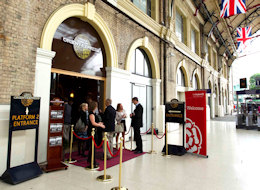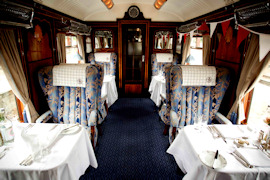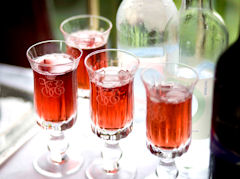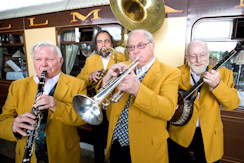Jump aboard the Orient-Express
Immortalized in an Agatha Christie novel, the Orient-Express proudly evokes travel from a bygone age. With lavish carriages and extravagant cuisine, the train attracts rail and history buffs and fans of fine dining. US visitor Tessa ten Cate jumps aboard for a day trip through the English countryside to find out whether the allure lives up to the hype.
First impressions
My journey on the British Pullman Orient-Express commences at 10.30am in London’s Victoria Station in a 1920s-themed lounge with royal-blue sofas and hosts dressed in traditional bow-tie attire with white shoulder pads and golden embellishments. The carpeting leads the way to the check-in counter where I am handed a boarding pass in a genuine leather holder. A few minutes later, as passengers meet and greet each other, there is a sense of mounting excitement.
 Check in for your journey on a red-carpeted platform
Check in for your journey on a red-carpeted platformVenice Simplon-Orient-Express
As the train approaches the platform, we head towards the enormous vehicle painted in crème and maroon brown colours, with ‘British Pullman’ spelled out in large golden letters across the top. Each carriage boasts its own name and history. Near the end of the train, I board the Lucille Carriage, one of the newest additions, and am led to my window seat and welcomed with a refreshing glass of Prosecco.
On board
The carriage decorations are authentic with old-fashioned lamp shades on each table and marquetry panels, polished wood sliced to form vase-like shapes on the walls. Passengers are arranged in paisley cushioned seating areas with anywhere between one and five people at a table. The chairs are quite large, with wooden arm rests, and are positioned directly next to the windows. The windows are framed with metal baggage compartments and thick curtains, giving the carriage a darker vintage look. There is a range of ages on board and each carriage has approximately three members of staff, once again dressed in 1920s suits.
 Step on board and enter the 1920s
Step on board and enter the 1920sVenice Simplon-Orient-Express
Food and drink
There is a never-ending supply of food during the day and wine also flows. The first sign of delectable cooking is a series of intricate starter bites followed by the first course, a tian of Cornish crab meat on grilled summer vegetables, nasturtium (an edible orange flower) salad, basil dressing and black olive tapenade.
The next course is a garden pea and Suffolk ham hock soup, followed by the main course, a roast breast of Kentish guinea fowl on asparagus, spice puy lentils, tarragon sauce and potato gratin. Each course is prepared using ingredients from various English regions, which is particularly noticeable with the cheese platter and biscuits.
At times, I have to inquire what exactly was on my plate, but overall the taste and portions of the food are ideal. As we tuck in and the flavours improve, all the diners look more than satisfied.
 Sparkling drinks for every guest
Sparkling drinks for every guestVenice Simplon-Orient-Express
After touring Kent, the train comes to a stop at 4.40pm in Whitstable. At the station, a four-man band plays powerful music from the Golden Age as we are offered a refreshing glass of sparkling champagne and locally collected oysters. Everyone goes back on board and my favourite course circulates the carriages: a series of pudding stacks and mixed berries. In the last hour of our rail journey, each table is left with a tray of mixed chocolates.
Service
Staff in the Lucille Carriage are lovely. They visit each table frequently to refill glasses and serve dishes unobtrusively. While the occasional spill of vegetable servings does take place, the staff calmly cleans and replaces the table’s dining sets. The gourmet courses are served at a leisurely pace, with enough time for me to finish my plate and chat without becoming too anxious for the next adorned dish.
 A four-person band at the Whistable platform
A four-person band at the Whistable platformVenice Simplon-Orient-Express
Journey
Our day trip – ‘The Golden Age of Travel’ – takes in portions of Surrey, Kent and Essex before returning to central London. We pass 57 railway stations covering 275km (171 miles), taking in forests, castles, creeks, rivers, mills and cathedrals.
End of the line
The service on board the Orient-Express is impeccable and the cuisine is delectable. While the trip is worth the price, there is room for improvement. While each passenger is provided with a map of the train’s route and itinerary, there is no way to know what part of England you are looking at as you pass through. An occasional announcement from the staff as to the journey’s progress and what sights to look out for would be a great enhancement.
However, my experience on board the Orient-Express more than lives up to its expectations as a charming, once-in-a-lifetime journey.
Website: www.orient-express.com/web/uktr/journeys/4_144426.jsp
Prices: From £395pp, including a five-course lunch with champagne and half a bottle of wine per person.
Do you have any Feedback about this page?
© 2025 Columbus Travel Media Ltd. All rights reserved. No part of this site may be reproduced without our written permission, click here for information on Columbus Content Solutions.









 You know where
You know where